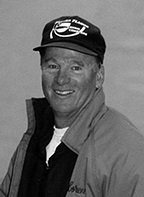Becoming A Published Author
Agony and Ecstasy of Writing a Book
By Evan and Lois Swensen
Chapter Nine
Fish, Oil, & Follies
Loren B. Flagg

I was named after my great-grandfather, Loren Augustus Flagg. Growing up as a teenager in Southeastern Massachusetts, I became interested, perhaps fascinated, by the life he had led in the late 1800s and early 1900s. There were a few pictures of deer hunts in Maine, boats he had built, and the East Bridgewater fire department staff where he had served as assistant engineer. There were several old guns he had passed down, including a Civil War era Spencer 56/50-caliber carbine—a gun that had been used by the Union Cavalry, including Custer, at Gettysburg and had helped turn the tide of the battle. There were also several of his old wildlife mounts, including a couple of trophy-sized whitetails that had been relegated to the upper hayloft in our early-19th-century New England barn. He had been a carpenter in his early years, and many old tools from his trade were still lying around in the barn and a small shop off to the side. Later he became a businessman and eventually purchased a large general store in the center of Elmwood, which he managed, along with becoming postmaster for the village.
All of the above intrigued me, but there was one thing sorely missing. There were no diaries, no notebooks, logs, or any narrative describing my great-grandfather’s life. I often thought how sad that this history was lost forever. How neat it would have been to stumble across some narrative of his life to go along with the evidence left behind. And therein lies a big part of the answer to the question of “why” I decided to write my book. My book was a memoir centered around my life as a fisherman, fisheries biologist, fishing guide, and fisheries consultant. I thought that perhaps someday my grandchildren, great-grandchildren, and maybe even beyond would be interested in what kind of life old great-granddaddy had led!
I had another reason to write a book. There had been two significant historical events in Homer and lower Cook Inlet history involving the oil industry, and I had been involved smack in the middle of both. The first occurred in the early to mid-1970s when the state sold oil leases in Kachemak Bay and later bought them back. This was an unprecedented action and a very rare victory for citizens fighting against Big Oil. The second event occurred in 1989 when the Exxon Valdez went on the rocks in Prince William Sound, and oil from the resulting spill entered Cook Inlet and Kachemak Bay. I wanted to give a first-hand account of my experience during these events.
And now for the “how” of writing my fisheries book. It seems that things just fell into place. First of all, as a wildlife biology major at Umass, I was encouraged early on by one of my professors to maintain a diary or log of all my field trips. This I did during my career as a fisheries biologist, first in Massachusetts, then Florida, and finally Alaska. I extended this practice to hunting and fishing trips, including my guide years on the Kenai River. I also had made a practice of taking photos of friends, coworkers, fisheries projects, scenery, and fish and game harvested during most of my various outings. So when the time came to begin my book, I had the resources to draw on to supplement my memory and thus provide a more complete and accurate portrayal of past events.
Getting started seemed to be the hardest part. Inspiration was provided by my wife, Sandra, when upon seeing boredom set in during my first year of full retirement, she asked, “Dear, why don’t you write a book?” Recalling the Chinese proverb that “a journey of a thousand miles begins with a single step,” I decided to apply this philosophy to starting my book. I decided that I wanted to document my experiences and career chronologically so in my mind, I could see this project play out chapter by chapter. The first step was to write an introduction; after that, chapter 1, then 2, and so forth. As I wrote each chapter, I attempted to locate any photos that would complement that chapter and then label them appropriately. After completing each chapter, it might be days, weeks, or even months before I began the next. I would wait for the right combination of time available along with inspiration to start the next chapter. Once started on a new chapter, I typically completed it in a day or two. And so, about a year and a half later, I finally finished the book!
Now, what to do next? I got online and researched various methods of publishing and then wrote letters to several publishers. Some wrote back, and others were too busy, or I was too small fry for them. Some of those writing back wanted a lot of money upfront, and others sent somewhat confusing details describing their process. I was examining two of these proposals and looking into self-publishing when a friend told me about Publication Consultants in Anchorage. I checked out their website and was immediately impressed. Publication Consultants, owned and operated by Evan Swensen, offered five options for publishing my book. These ranged from Evan’s just acting as a consultant to his outright purchase my manuscript. I keyed in on a midlevel option that basically provided a partnership between writer and publisher. My thought was that as a partner, the publisher would be motivated to produce the best product possible and then follow up with a good marketing and distribution plan. We would sign a publication agreement, and he would then be responsible for the business details that I had little interest in. These included obtaining the copyright, the Library of Congress number, and all the everyday business transactions associated with delivering a book to market. Boy, what a relief that I would not have to deal with these issues!
This all sounded good on the Internet and telephone, but I wanted to meet Evan and see if he was someone I could work with. When I did so, I came away assured that this was the right way to go for me. Evan was friendly, easy to talk to, and an expert in the business of publishing. He gave me a cost estimate that ultimately proved accurate, and we soon signed an agreement. After that, there were only a few minor bumps along the road to a finished product. Projects left included final editing, coming up with a title, and finally, a book cover design. Then it was off to the printer.
It was an exciting day when the first box of books arrived at our doorstep! The first step was to mail a few books off to relatives, close friends, and those who had helped with various parts of the project such as editing, cover design, writing back-cover blips, or the foreword. Soon after, I was fully engaged in book signings at various locations in Kenai, Soldotna, Homer, Anchorage, and Wasilla. This was followed by attempts to personally market and distribute my book to various smaller stores on the Kenai Peninsula that traditionally carried Alaskana and other books by local authors. Some of these stores, including gift shops, would purchase your book outright, while others stocked books on consignment with commissions paid later. This is fine, but it takes several follow-up visits to obtain payments and restock shelves when needed.
Final marketing efforts included a mail-out introducing the new book and attending a few craft fairs and Christmas bazaar events. Within the first year, I had recovered all costs associated with producing the book, which had been my original goal. And so it goes for the new author! Good luck to all who attempt this rewarding endeavor.


